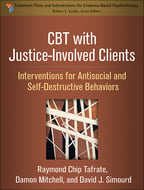
In our previous blog, we described the importance of risk reduction and the Central Eight risk domains. In this blog, we present some elements of risk models that often go unnoticed by practitioners. We believe these features of criminal risk, when applied thoughtfully, powerfully enhance supervision and case management practices. Here is how we think about risk in our work with justice-involved clients (JICs).
1. An optimistic outlook: Most risk domains for criminal behavior are changeable
As we noted in our first blog, working in the criminal justice area can be negative. We believe the criminal risk model offers an optimistic view of human nature because the majority of risk domains are changeable. Seven of the eight domains have dynamic components (the one exception is history of criminal/antisocial behavior). We approach our work with optimism because JICs’ criminal trajectories can be altered if intervention can improve their functioning within the unique constellation of risk domains relevant to their lives.
2. A preventive orientation
Returning to the heart disease example, the cardiologist who accurately assesses and documents a patient’s risk factors but does little to reduce the chance of a cardiac event is not the type of physician we would want. Yet, in some forensic settings this exact scenario occurs; a core activity among practitioners becomes “documenting a JIC’s path to failure.” When a risk reduction perspective is applied to criminal behavior, the orientation is strongly preventive; the aim is to reduce risk before the person suffers more serious losses and consequences. Since re-offending is the outcome of most concern, the goal of intervention is to reduce a JIC’s risk profile as much as possible before more crimes are committed, which creates more harm to the JIC’s life as well as others.
3. An emphasis on approach goals: Addressing risk doesn’t just mean avoiding risk
Intervention does not simply involve providing JICs with a checklist of people, places, and situations to avoid. Developing approach goals, that is – assisting JICs in pursuing valued life directions in ways that combat the riskiest aspects of their lives – is equally important. Examples include having success in school or work, acquiring and spending time with prosocial friends, and developing more positive family or marital relationships. In changing critical domains of their lives, JICs will often need to acquire new skills, competencies, routines, and thinking patterns. Of course, improving a JIC’s functioning in any given risk domain may involve a blend of both approach and avoidance goals (e.g., distancing from a risky friend while at the same time re-establishing prosocial relationships that have become dormant). Also, the current debate over deficit versus strength-based paradigms seems unnecessary to us because delivering CBT interventions from a risk reduction perspective should be optimistic, creative, oriented around approach goals, and compatible with developing and working with JICs’ strengths.
4. Individually tailored: Case planning is not “cookie cutter”
Case planning should address the risk domains relevant to a JIC’s particular case. Take care to avoid the “one size fits all” approach that often creeps into forensic programming, in which every JIC is provided with the same program, regardless of the program components and their applicability to the person’s risk profile. It is important to consider individual differences in how a given risk domain translates into criminal behavior. For example, two JICs may both have problems with antisocial companions, but how their companions influence criminal behavior may be different. One JIC’s friends may present opportunities for impulsive, criminal activities the person might not have sought out or initiated independently. For another JIC, the desire to obtain the respect of friends may lead the JIC to initiate criminal behavior that he or she believes will meet their approval. In order to achieve optimal success with each case, it’s best to be flexible when attempting alter JICs’ patterns of functioning within risk domains areas.
5. Risk factors are synergistic: They interact in ways that can amplify or reduce each other
It’s important to appreciate the interrelationships between risk domains and the unique ways they may be manifested across individuals. Given the multidetermined nature of human behavior, risk domains are often connected in ways that can be complex in how they amplify or reduce each other. In case of Chloe (presented in blog #4), she spends the better part of her considerable free time with friends who drink heavily, smoke pot, and steal cars. Her friends reinforce her unproductive beliefs about pursuing school or meaningful employment, and her cannabis use worsens her potential school performance or marketability as an employee. Her friends also reinforce her excitement seeking attitudes, her sense that she doesn’t fit in with conventional school or work activities and encourage increasing levels of risky behavior. Thus, the various risk domains relevant to forensic cases often influence each other in an interrelated destructive system. Due to such synergistic effects, the influence of risk domains can be multiplicative rather than simply additive.
On the optimistic side, because the domains are interconnected, a positive change in one of these areas can facilitate positive changes in the others. For example, if intervention could successfully address the influence of Chloe’s antisocial companions, she might be willing to pursue education or employment. A more productive daily routine would result in less time with her antisocial friends, less time to engage in substance use, and exposure to new peers who express prosocial thoughts and who model more productive lifestyles. Even with high risk cases, where the majority of risk domains pop, you do not have to address all the areas. A strategic focus on one or two risk domains can often create a positive ripple effect in a JIC’s life.
6. JIC awareness and motivation is not assumed
In the example of heart disease, it’s possible for people to be at high risk for heart disease and have few noticeable symptoms, to be relatively unaware of how their current lifestyles undermine their long-term well-being, and not to consider change until they suffer a cardiac event. Similarly, chronic criminality has been described as a lifestyle disorder that develops over time and that affects judgment and behavior. Forensic clients can remain relatively unaware of their problematic patterns until they have suffered serious losses (e.g., incarceration, reincarceration, financial instability, damaged relationships). This is a stark contrast to clients who voluntarily seek out help for mental health problems to alleviate subjective distress. Mental health interventions usually focus on diagnosable disorders and it’s the client’s symptoms associated with those disorders that are viewed as the problems to be resolved. An important implication of approaching JICs from a risk perspective (as opposed to a symptom/disorder perspective) is that you will need to spend time enhancing JIC awareness and motivation to change the risk-relevant areas of their lives.
7. Defines the area of expertise for community corrections professionals
In many settings, risk models define the professional area of expertise. Practitioners become experts at addressing those factors that contribute to problematic outcomes, which become the focus of assessment, intervention, and office visits. There is currently a debate for the heart and soul of community corrections work. What is the job of community corrections officers and case managers? Is it primarily to monitor adherence to the mandates of probation or is it to facilitate behavior change in clients? Increasingly, correctional agencies around the world are being asked to do more than temporarily control or sanction the population under their authority; they are expected to positively influence the behavioral trajectories of their clients. We are often asked, “Well aren’t you just trying to turn probation officers into social workers or therapists?” The answer is always a very enthusiastic “No.” Few social workers (counselors, psychologists, marriage and family therapists, etc.) understand risk domain areas and actively work to reduce these main drivers of criminal behavior. We believe that the field of community corrections can produce very positive outcomes for JICs and the community at large: It’s reducing criminal risk!
 What works and doesn’t work when using Cognitive-behavioral therapy (CBT)? This is something the authors, Raymond Chip Tafrate, PhD, Damon Mitchell, PhD, & David J. Simourd, PhD, of this blog series have spent a long time studying and have put all they’ve learned in the book: CBT with Justice-Involved Clients: Interventions for antisocial and self-destructive behaviors. We thought our subscribers would be interested in a blog series on this content, knowing so many use or refer their clients to this type of treatment. Therefore, we are pleased to announce a blog series on Adapting CBT for Justice-Involved Clients.
What works and doesn’t work when using Cognitive-behavioral therapy (CBT)? This is something the authors, Raymond Chip Tafrate, PhD, Damon Mitchell, PhD, & David J. Simourd, PhD, of this blog series have spent a long time studying and have put all they’ve learned in the book: CBT with Justice-Involved Clients: Interventions for antisocial and self-destructive behaviors. We thought our subscribers would be interested in a blog series on this content, knowing so many use or refer their clients to this type of treatment. Therefore, we are pleased to announce a blog series on Adapting CBT for Justice-Involved Clients.
The trajectory of the science and practice of cognitive-behavioral therapy (CBT) models began with a focus on internalizing mental health syndromes such as depression and anxiety and was later extended to externalizing problems such as substance misuse, anger dysregulation, and personality pathology. Although CBT has grown into a large collection of interventions applicable to diverse client groups, attention to justice-involved clients (JICs) is substantially more limited. This is noteworthy because CBT has been found to be effective in addressing the self-destructive patterns common among JICs. This suggests that interventions using CBT techniques can alter the criminal risk potential of JICs, which in turn may lead to less risky decision-making and behaviors, and ultimately a safer society.
The practical application of any intervention approach often requires adaptation when delivered to a unique client group; and this occurs with CBT and JICs. We have been fortunate to have been involved in vast activities with JICs over the years. This has included developing and implementing intervention programs, providing training, consultation, and direct service to JICs. We have also worked with front-line criminal justice personnel in both custody and community settings. CBT techniques have been a constant theme in all our work with JICs and criminal justice personnel. Along the way, we have refined what works, eliminated what didn’t work, and examined the impact the interventions had on recidivism. In this blog series we will discuss what we have learned about tailoring CBT when working with JICs within a community corrections context.
|
Raymond Chip Tafrate, PhD |
Damon Mitchell, PhD |
David J. Simourd, PhD |
* These blogs are meant to present brief tips and strategies for agencies, programs, and practitioners. Readers who want more science, history, or detailed descriptions of “how to” conduct forensic CBT interventions may consider the following resource: CBT with justice-involved clients: Interventions for antisocial and self-destructive behaviors.
** There are many terms commonly used to describe people receiving services in criminal justice settings: offender, juvenile delinquent, probationer, parolee, prisoner, inmate, court mandated client, and patient, to name just a few. We commonly use the term justice-involved client (JIC). The abbreviation JIC is not intended to communicate any notion of inherent badness; instead, it’s meant to convey the complexities and challenges associated with the larger context in which intervention is delivered, while sidestepping the pitfalls of pejorative labels.




